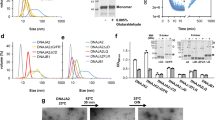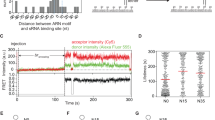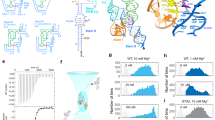Abstract
DExD/H-box proteins are ubiquitously involved in RNA-mediated processes and use ATP to accelerate conformational changes in RNA. However, their mechanisms of action, and what determines which RNA species are targeted, are not well understood. Here we show that the DExD/H-box protein CYT-19, a general RNA chaperone, mediates ATP-dependent unfolding of both the native conformation and a long-lived misfolded conformation of a group I catalytic RNA with efficiencies that depend on the stabilities of the RNA species but not on specific structural features. CYT-19 then allows the RNA to refold, changing the distribution from equilibrium to kinetic control. Because misfolding is favoured kinetically, conditions that allow unfolding of the native RNA yield large increases in the population of misfolded species. Our results suggest that DExD/H-box proteins act with sufficient breadth and efficiency to allow structured RNAs to populate a wider range of conformations than would be present at equilibrium. Thus, RNAs may face selective pressure to stabilize their active conformations relative to inactive ones to avoid significant redistribution by DExD/H-box proteins. Conversely, RNAs whose functions depend on forming multiple conformations may rely on DExD/H-box proteins to increase the populations of less stable conformations, thereby increasing their overall efficiencies.
This is a preview of subscription content, access via your institution
Access options
Subscribe to this journal
Receive 51 print issues and online access
$199.00 per year
only $3.90 per issue
Buy this article
- Purchase on Springer Link
- Instant access to full article PDF
Prices may be subject to local taxes which are calculated during checkout




Similar content being viewed by others
References
Tanner, N. K. & Linder, P. DExD/H box RNA helicases: from generic motors to specific dissociation functions. Mol. Cell 8, 251–262 (2001)
Jankowsky, E. & Fairman, M. E. RNA helicases—one fold for many functions. Curr. Opin. Struct. Biol. 17, 316–324 (2007)
Gorbalenya, A. E. & Koonin, E. V. Helicases: amino acid sequence comparisons and structure–function relationships. Curr. Opin. Struct. Biol. 3, 419–429 (1993)
Shuman, S. Vaccinia virus RNA helicase: an essential enzyme related to the DE-H family of RNA-dependent NTPases. Proc. Natl Acad. Sci. USA 89, 10935–10939 (1992)
Jankowsky, E., Gross, C. H., Shuman, S. & Pyle, A. M. The DExH protein NPH-II is a processive and directional motor for unwinding RNA. Nature 403, 447–451 (2000)
Pang, P. S., Jankowsky, E., Planet, P. J. & Pyle, A. M. The hepatitis C viral NS3 protein is a processive DNA helicase with cofactor enhanced RNA unwinding. EMBO J. 21, 1168–1176 (2002)
Linder, P. Dead-box proteins: a family affair—active and passive players in RNP-remodeling. Nucleic Acids Res. 34, 4168–4180 (2006)
Rogers, G. W., Richter, N. J. & Merrick, W. C. Biochemical and kinetic characterization of the RNA helicase activity of eukaryotic initiation factor 4A. J. Biol. Chem. 274, 12236–12244 (1999)
Fairman, M. E. et al. Protein displacement by DExH/D RNA helicases without duplex unwinding. Science 304, 730–734 (2004)
Yang, Q. & Jankowsky, E. The DEAD-box protein Ded1 unwinds RNA duplexes by a mode distinct from translocating helicases. Nat. Struct. Mol. Biol. 13, 981–986 (2006)
Yang, Q., Fairman, M. E. & Jankowsky, E. DEAD-box-protein-assisted RNA structure conversion towards and against thermodynamic equilibrium values. J. Mol. Biol. 368, 1087–1100 (2007)
Mohr, S., Stryker, J. M. & Lambowitz, A. M. A DEAD-box protein functions as an ATP-dependent RNA chaperone in group I intron splicing. Cell 109, 769–779 (2002)
Huang, H. R. et al. The splicing of yeast mitochondrial group I and group II introns requires a DEAD-box protein with RNA chaperone function. Proc. Natl Acad. Sci. USA 102, 163–168 (2005)
Mohr, S., Matsuura, M., Perlman, P. S. & Lambowitz, A. M. A DEAD-box protein alone promotes group II intron splicing and reverse splicing by acting as an RNA chaperone. Proc. Natl Acad. Sci. USA 103, 3569–3574 (2006)
Latham, J. A. & Cech, T. R. Defining the inside and outside of a catalytic RNA molecule. Science 245, 276–282 (1989)
Zarrinkar, P. P. & Williamson, J. R. Kinetic intermediates in RNA folding. Science 265, 918–924 (1994)
Sclavi, B., Sullivan, M., Chance, M. R., Brenowitz, M. & Woodson, S. A. RNA folding at millisecond intervals by synchrotron hydroxyl radical footprinting. Science 279, 1940–1943 (1998)
Treiber, D. K., Rook, M. S., Zarrinkar, P. P. & Williamson, J. R. Kinetic intermediates trapped by native interactions in RNA folding. Science 279, 1943–1946 (1998)
Russell, R., Millett, I. S., Doniach, S. & Herschlag, D. Small angle X-ray scattering reveals a compact intermediate in RNA folding. Nature Struct. Biol. 7, 367–370 (2000)
Russell, R. & Herschlag, D. New pathways in folding of the Tetrahymena group I RNA enzyme. J. Mol. Biol. 291, 1155–1167 (1999)
Pan, J., Deras, M. L. & Woodson, S. A. Fast folding of a ribozyme by stabilizing core interactions: Evidence for multiple folding pathways in RNA. J. Mol. Biol. 296, 133–144 (2000)
Russell, R. & Herschlag, D. Probing the folding landscape of the Tetrahymena ribozyme: Commitment to form the native conformation is late in the folding pathway. J. Mol. Biol. 308, 839–851 (2001)
Treiber, D. K. & Williamson, J. R. Concerted kinetic folding of a multidomain ribozyme with a disrupted loop-receptor interaction. J. Mol. Biol. 305, 11–21 (2001)
Russell, R. et al. Exploring the folding landscape of a structured RNA. Proc. Natl Acad. Sci. USA 99, 155–160 (2002)
Tijerina, P., Bhaskaran, H. & Russell, R. Non-specific binding to structured RNA and preferential unwinding of an exposed helix by the CYT-19 protein, a DEAD-box RNA chaperone. Proc. Natl Acad. Sci. USA 103, 16698–16703 (2006)
Grohman, J. K. et al. Probing the mechanisms of DEAD-box proteins as general RNA chaperones: The C-terminal domain of CYT-19 mediates general recognition of RNA. Biochemistry 46, 3013–3022 (2007)
Russell, R. et al. The paradoxical behavior of a highly structured misfolded intermediate in RNA folding. J. Mol. Biol. 363, 531–544 (2006)
Del Campo, M. et al. Do DEAD-box proteins promote group II intron splicing without unwinding RNA? Mol. Cell (in the press)
Johnson, T. H., Tijerina, P., Chadee, A. B., Herschlag, D. & Russell, R. Structural specificity conferred by a group I RNA peripheral element. Proc. Natl Acad. Sci. USA 102, 10176–10181 (2005)
Battle, D. J. & Doudna, J. A. Specificity of RNA-RNA helix recognition. Proc. Natl Acad. Sci. USA 99, 11676–11681 (2002)
Joyce, G. F., van der Horst, G. & Inoue, T. Catalytic activity is retained in the Tetrahymena group I intron despite removal of the large extension of element P5. Nucleic Acids Res. 17, 7879–7889 (1989)
Lambowitz, A. M., Caprara, M. G., Zimmerly, S. & Perlman, P. S. in The RNA World (eds Gesteland, R. F., Cech, T. R. & Atkins, J. F.) 451–485 (Cold Spring Harbor Laboratory Press, New York, 1999)
Mohr, G., Caprara, M. G., Guo, Q. & Lambowitz, A. M. A tyrosyl-tRNA synthetase can function similarly to an RNA structure in the Tetrahymena ribozyme. Nature 370, 147–150 (1994)
Russell, R., Tijerina, P., Chadee, A. B. & Bhaskaran, H. Deletion of the P5abc peripheral element accelerates early and late folding steps of the Tetrahymena group I ribozyme. Biochemistry 46, 4951–4961 (2007)
Karpel, R. L., Miller, N. S. & Fresco, J. R. Mechanistic studies of ribonucleic acid renaturation by a helix-destabilizing protein. Biochemistry 21, 2102–2108 (1982)
Herschlag, D. RNA chaperones and the RNA folding problem. J. Biol. Chem. 270, 20871–20874 (1995)
Thirumalai, D. & Hyeon, C. RNA and protein folding: common themes and variations. Biochemistry 44, 4957–4970 (2005)
Mahen, E. M., Harger, J. W., Calderon, E. M. & Fedor, M. J. Kinetics and thermodynamics make different contributions to RNA folding in vitro and in yeast. Mol. Cell 19, 27–37 (2005)
Grossberger, R. et al. Influence of RNA structural stability on the RNA chaperone activity of the Escherichia coli protein StpA. Nucleic Acids Res. 33, 2280–2289 (2005)
Lin, Z. & Rye, H. S. GroEL-mediated protein folding: making the impossible, possible. Crit. Rev. Biochem. Mol. Biol. 41, 211–239 (2006)
Stein, A. J., Fuchs, G., Fu, C., Wolin, S. L. & Reinisch, K. M. Structural insights into RNA quality control: the Ro autoantigen binds misfolded RNAs via its central cavity. Cell 121, 529–539 (2005)
Staley, J. P. & Guthrie, C. Mechanical devices of the spliceosome: motors, clocks, springs, and things. Cell 92, 315–326 (1998)
Schwer, B. A new twist on RNA helicases: DExH/D box proteins as RNPases. Nature Struct. Biol. 8, 113–116 (2001)
Rajewsky, N. microRNA target predictions in animals. Nature Genet. 38, S8–S13 (2006)
Schultes, E. A. & Bartel, D. P. One sequence, two ribozymes: implications for the emergence of new ribozyme folds. Science 289, 448–452 (2000)
Zaug, A. J., Grosshans, C. A. & Cech, T. R. Sequence-specific endoribonuclease activity of the Tetrahymena ribozyme: enhanced cleavage of certain oligonucleotide substrates that form mismatched ribozyme–substrate complexes. Biochemistry 27, 8924–8931 (1988)
van der Horst, G., Christian, A. & Inoue, T. Reconstitution of a group I intron self-splicing reaction with an activator RNA. Proc. Natl Acad. Sci. USA 88, 184–188 (1991)
Herschlag, D. & Cech, T. R. Catalysis of RNA cleavage by the Tetrahymena thermophila ribozyme. 1. Kinetic description of the reaction of an RNA substrate complementary to the active site. Biochemistry 29, 10159–10171 (1990)
Acknowledgements
We thank P. Tijerina and J. Grohman for purification of CYT-19; R. Coon for purification of CYT-18; D. Herschlag and A. Lambowitz for discussions and comments on the manuscript; and K. Johnson for sharing an unpublished version of the simulation program Kinetic Explorer. This work was funded by grants from the Welch Foundation and the National Institutes of Health (to R.R.).
Author Contributions H.B. performed the experiments; R.R. and H.B. designed the study, interpreted results, and wrote the paper.
Author information
Authors and Affiliations
Corresponding author
Ethics declarations
Competing interests
The authors declare no competing financial interests.
Supplementary information
Supplementary Figures
The file contains Supplementary Figures 1-6 with Legends and additional references. (PDF 641 kb)
Rights and permissions
About this article
Cite this article
Bhaskaran, H., Russell, R. Kinetic redistribution of native and misfolded RNAs by a DEAD-box chaperone. Nature 449, 1014–1018 (2007). https://doi.org/10.1038/nature06235
Received:
Accepted:
Issue Date:
DOI: https://doi.org/10.1038/nature06235
This article is cited by
-
Functional and structural basis of extreme conservation in vertebrate 5′ untranslated regions
Nature Genetics (2021)
-
Chaperones convert the energy from ATP into the nonequilibrium stabilization of native proteins
Nature Chemical Biology (2018)
-
Rapid RNA–ligand interaction analysis through high-information content conformational and stability landscapes
Nature Communications (2015)
-
A transcriptomic analysis of Chrysanthemum nankingense provides insights into the basis of low temperature tolerance
BMC Genomics (2014)
Comments
By submitting a comment you agree to abide by our Terms and Community Guidelines. If you find something abusive or that does not comply with our terms or guidelines please flag it as inappropriate.



